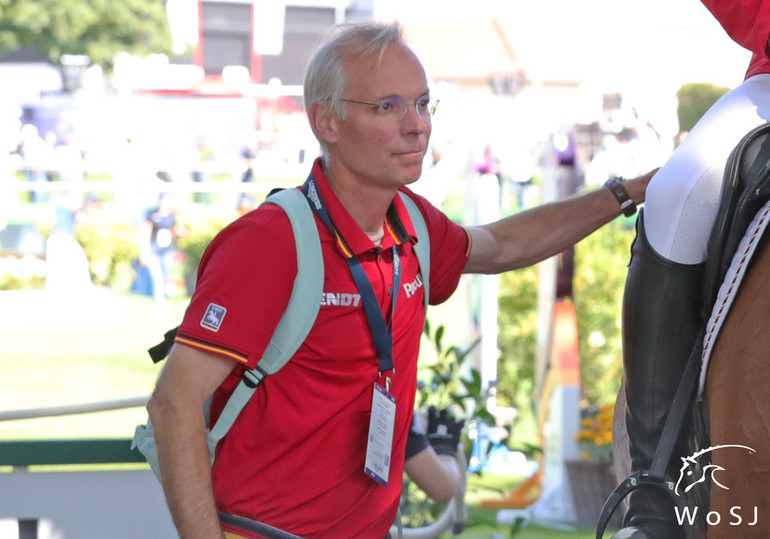Text © World of Showjumping
How should equine inflammation be approached, when should anti-inflammatory methods be used and what part should icing and medicaments play in helping horses to recover after competition and exercise? While excessive inflammation causes tissue damage and can lead to a number of other issues – including pain – the inflammatory cascade is in fact necessary to bring cells to the localized regions of tissue that need to be repaired and regenerated after exercise [1]. Even though inflammation is often considered as a purely negative process, there is growing scientific evidence [2] to support the positive impact that tightly regulated inflammation has on repairing muscles, tendons and ligaments after exercise. World of Showjumping spoke with Dr. Jan-Hein Swagemakers and Dr. Tim Worden to learn more.
Dr. Jan-Hein Swagemakers is a FEI permitted treating veterinarian, an equine chiropractor and a well-known face on the international showjumping circuit: He has functioned as the German team veterinarian since 2009 and runs his own clinic – Tierklinik Lüsche in Germany.
Dr. Tim Worden is a Canadian sports scientist who has worked with numerous FEI-level showjumping riders, has a PhD in biomechanics and specializes in applying high-performance training techniques to horses. He is also a member of the Equine High-Performance Sports Group, co-Host of the Sport Horse Podcast, and is Business Development Manager for Inteligex – a biotechnology company developing stem cell therapies for nervous system injury.
Recovery
It is important to understand that what happens before and during exercise plays an important part in determining the horses’ ability to recover afterwards. “Recovery means the body restoring its strength, energy and the elasticity of the tendons, as well as repairing the micro-damage in the cartilage,” Swagemakers explains. “The body needs time to recover, and the warm-up, as well as the cooling down, are important parts of it. What happens before and after a big workload should not be neglected; increasing the blood flow is needed prior, and a certain amount of post-work movement for cooling down the body is essential. Another aspect of recovery is that there is the body, and then there is the mind – and we have to take care of both, the way we do for ourselves as well.”
What happens before and after a big workload should not be neglected
“Recovery is a mixture of movement and keeping the blood circulation going,” Swagemakers continues. “For horses, a certain amount of movement is really important. Additionally, we have to make sure that if inflammation takes place, it doesn’t get out of hand – especially if the horse has to perform again one or two days later. However, you need some inflammation to be able to recover as well.”
“When it comes to training, the most important point is thinking about how to introduce stressors to cause adaptations in the body,” Worden fills in. “On one hand, we use physical exercise and mental preparation techniques to stress the body to prepare it for future competition and higher workloads. However, it is critical to balance stressors with activities and tools that will allow horses to relax and regenerate between workouts. To figure out the best possible recovery for a horse, we have to understand what each individual horse likes to do – if a horse enjoys hacking in the woods, that would be a good way to recover. For most horses, the best recovery would be to go in the paddock, where they can move freely to stimulate blood flow, remove waste by-products from their muscles and mentally recharge.”
Inflammation to stimulate growth
“In the past, inflammation was considered a negative process to be avoided,” Worden explains. “We now know that in the hours after exercise we need inflammation to remove damaged tissue and promote the growth of new healthy muscle, tendon, ligament and bone. Without inflammation, a horse would never be able to adapt to training and get stronger, because you do need the inflammatory process to stimulate growth. However, it is important to note that inflammation can get out of control, and in situations where there is chronic inflammation, it is possible to run into trouble.”
Without inflammation, a horse would never be able to adapt to training
“This also relates back to the saying about horses only having a certain number of jumps in them, which does not align with how bodies respond to training,” Worden continues. “Many still think that tendons don’t remodel after exercise, but with more and more research [3], we see that is untrue. In fact, if we take findings from scientific literature about how best to stimulate tendons and ligaments to grow and adapt, there are opportunities to develop horses that will be more robust and less likely to suffer catastrophic injuries. Theoretically, the end goal of training, is to get the horses moving more efficiently so that they are better equipped to jump. If inflammation is kept in check and you have the right training program, you will have progress, not injuries.”
“To train tendons, ligaments and joints, we need to load them multiple times per day,” Worden points out. “Hence, the more time the horse spends out of the stall the better. A good goal is to have horses worked at least twice a day, because tendons and ligaments respond best to multiple stimulations per day. The workouts don’t need to be long or very intense, but the tissues need these molecular signals to grow in a healthy and effective way.”
Icing
Using different types of ice boots or other methods of cooling down the horses’ legs is common practice, but is there scientific proof that this helps the horses recover? “Icing should be decided upon individually, and as it is done now for a lot of horses – the way that it is simply made as a routine – is not good,” Swagemakers says. “Icing after work, for a certain amount of time and every time – that is not always necessary. What do you want to achieve with icing? A decrease in temperature for the muscles and the whole body makes sense if there is an overheating – for example if you have a really hot climate, where it is important to not let the body get too hot. However, a certain amount of inflammation is important for the body to recover and an increased blood flow is especially important for the recovery of muscles, tendons and joints. When horses move, there is always a little bit of damage that occurs – micro-damage – and that needs continuous repair. You should never see the icing upon icing alone, but consider it as a part of a whole program of rehabilitation. It should fit well in the training and that must be defined individually from one horse to the other.”
A certain amount of inflammation is important for the body to recover
“You need increased blood circulation for recovery, and if you decrease it by icing and stop the inflammation that is needed, it can have a negative effect,” Swagemakers continues. “On the other hand, the body tends to over-do the inflammation, so icing often is good if the body starts to over-react to inflammation – which it does with a lot of trauma. If you have an acute inflammation, icing definitely makes sense, because you don’t want the inflammation to get into a vicious circle where it gets worse and worse. Until the repair mechanisms start going, you do want increased blood flow, so you have to find a balance between icing and increasing blood flow.”
“There is for sure a time and place for icing, but it seems many programs aren’t following the evidence and are over-reliant on it,” Worden explains. “In healthy bodies, we want to allow the normal inflammatory cascade to occur so the musculoskeletal system can repair and become more robust – and icing likely interferes with the normal inflammatory process to a degree. Conversely, if an injury has been sustained, or if an athlete needs to perform at a high level for multiple days in a row and there is not enough time for the normal recovery process to take place, then cryotherapy could be warranted.”
Pain and anti-inflammatory medicine
Using anti-inflammatory medication to avoid inflammation, possible pain can be covered up. “I am not in favour of anti-inflammatory medication right after a show or a class, because it has too strong of a painkilling effect,” Swagemakers says. “I think pain also has a protective effect; it makes sure the individual does not over-do things. Again, it is as with icing; for certain horses, giving some anti-inflammatory medication might make sense, but don’t over-do it – because it will cause the horse to damage itself easier. If a horse is healthy, it does not need anti-inflammatory medication after a performance.”
Pain also has a protective effect
“As soon as there is pain somewhere in the body, an athlete is more likely to get injured,” Worden points out. “With pain, we begin to move differently to protect the affected areas, which causes a cascade of changes – including inefficient movement mechanics. Using products that block pain to continue training or competing means that you are more likely to create a larger injury down the road. The question is, should we even be blocking pain? Pain is there to be a warning sign and when you are training, there should not be any pain. It is very hard for an athlete to progress and become better if they are constantly battling minor injuries that impact their training. Also, from a philosophical perspective, if you win with a horse whose body breaks down in six months or a year, is that truly a win? When it comes to anti-inflammatory medicine, the question is; do short-term gains sacrifice the long-term potential and wellness of the horse?”
[1] Peake JM, Neubauer O, Della Gatta PA, Nosaka K. Muscle damage and inflammation during recovery from exercise. J Appl Physiol (1985). 2017 Mar 1;122(3):559-570. doi: 10.1152/japplphysiol.00971.2016. Epub 2016 Dec 29. PMID: 28035017.
[2] Roberts LA, Raastad T, Markworth JF, Figueiredo VC, Egner IM, Shield A, Cameron-Smith D, Coombes JS, Peake JM. Post-exercise cold water immersion attenuates acute anabolic signalling and long-term adaptations in muscle to strength training. J Physiol. 2015 Sep 15;593(18):4285-301. doi: 10.1113/JP270570. Epub 2015 Aug 13. PMID: 26174323; PMCID: PMC4594298.
[3] Firth EC. The response of bone, articular cartilage and tendon to exercise in the horse. J Anat. 2006 Apr;208(4):513-26. doi: 10.1111/j.1469-7580.2006.00547.x. PMID: 16637875; PMCID: PMC2100207.
Kasashima Y, Smith RK, Birch HL, Takahashi T, Kusano K, Goodship AE. Exercise-induced tendon hypertrophy: cross-sectional area changes during growth are influenced by exercise. Equine Vet J Suppl. 2002 Sep;(34):264-8. doi: 10.1111/j.2042-3306.2002.tb05430.x. PMID: 12405698.
Cherdchutham W, Meershoek LS, van Weeren PR, Barneveld A. Effects of exercise on biomechanical properties of the superficial digital flexor tendon in foals. Am J Vet Res. 2001 Dec;62(12):1859-64. doi: 10.2460/ajvr.2001.62.1859. PMID: 11763171.
1.3.2023 No reproduction of any of the content in this article will be accepted without a written permission, all rights reserved © World of Showjumping.com. If copyright violations occur, a penalty fee will apply.









